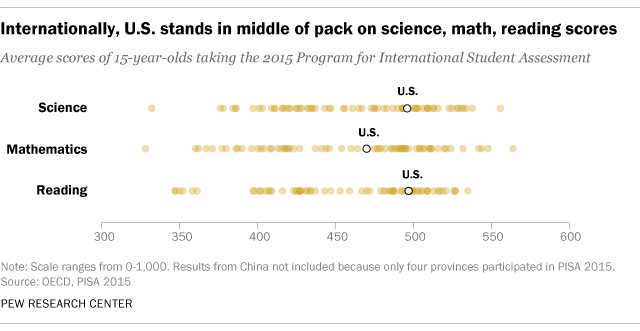Go straight to The Bottom Line
For many parents, this is the real bottom line: Will my kids be prepared for the future? For Americans of all ages, this is a broader question. In the 21st-century economy, we are all learners and the education industry applies to all of us. It is the engine that helps our citizenry develop the skills we need to drive a 21st century economy and to solve the world’s problems.

This discussion is primarily focused on K-12 education, where the federal government has played a significant role (especially since No Child Left Behind). What does it mean to be a “prepared” graduate in 2020? How can we ensure equitable access to all forms of postsecondary education?
These discussions have been the primary focus of educational think tanks and conferences on education policy for over two decades, but they have a particular urgency because of the pandemic. The need for social distancing and quarantining during Covid-19 outbreaks has school systems scrambling to provide hybrid models of learning and educators asking themselves, more intently than ever, what is truly essential for our students to know and be able to do in order to ease the strain on kids, educators, and families.
Which of the candidates for President is best positioned to steer the federal government’s role in all of this?
The criteria by which you measure “good education” for a nation has been a point of contention. Typical measures are graduation rate (percentage of kids who graduate within four years of 9th grade) and college admissions rate. The National Center for Education Statistics reports that the adjusted cohort graduation rate (ACGR) was 85%, with some variation among the states , with other sources reporting it as high as 88%. All sources report that, generally, graduation rates have been rising steadily for the past ten years. Graduation rates are, in fact, higher than they have been in history – which feels like good news! – though some question the simplicity of that picture. The story for college enrollment is somewhat more nuanced, with enrollment growing steadily (though slowly) from 2000 to 2010, and then remaining essentially level since then. For the purposes of this paper, the steady improvement of these measures has happened regardless of the party in power. Compared to our international peers, the US has fostered a K-12 system that inarguably generates graduates who are less well prepared for the challenges of this century.

Biden vs. Trump
The Obama-Biden Department of Education reformed student loan processes (removing private banks from the mix), supported early childhood programs, cracked down on dubious “for profit” colleges, attempted to assure equity from state to state, and replaced the draconian No Child Left Behind measures with the more reasonable (though hardly without controversy) Every Student Succeeds Act. At the same time, Arne Duncan, Secretary of Education for most of that time, was unresponsive to advice from the field and overly focused on high stakes testing, according to some.
Trump’s Secretary of Education, Betsy DeVos, was selected for her track record of financial generosity to the Trump campaign for President – she certainly never would have been nominated on the results of her education reform work in her native Michigan. She never worked in public schools in any capacity, was never a parent to a public school student, and, in fact, never attended public schools herself. Her thoroughgoing support for school vouchers and privatization has been heard as disdain for public schools and sparked opposition right from the beginning. Even those who support charters and vouchers object to DeVos’s lack of commitment to accountability for those same schools.
There have been specific issues of contention – indifference to civil rights complaints in schools, embrace of for-profit colleges leading to massive student debt, making it harder for students in colleges to report sexual assault, and bad faith management of the Public Service Loan Forgiveness Program – as well as ethical issues and conflicts of interest. The problem, though, is larger than any specific issue. As one writer put it, “Rather than offering a positive vision for the most diverse generation of students in American history, the Department of Education under DeVos failed to put forward any vision that is responsive to the needs of today’s students. In fact, this department has gone out of its way to gut protections and guidelines aimed at defending students and helping them succeed.”
Who Would Handle a Crisis Better?
Seven months ago, it would have seemed alarmist to even ask this question. Now it could not seem more pertinent. There is a pretty clear point of comparison between the Democrats and Republicans. When Obama-Biden came to office in 2008, the country was in economic free fall, tax bases were shrinking, and school districts were having to suddenly cut their budgets dramatically. Through the American Recovery and Investment Act (aka, the Stimulus), $4.35 billion went to the states’ Departments of Education to distribute via a competitive grant process. In K-12, monies supported teacher retainment and training, support of Title I, ELL, and special education programs. In higher education, funding flowed in primarily through student grants and research. In both cases, the resources stabilized institutions that otherwise would have been reeling.
The response by Trump and DeVos to the COVID crisis has been less helpful. Trump has extended relief to Student Loan holders, but any systemic fiscal support for schools has been undermined by Trump. The Senate and the House of Representatives have been unable to come to an agreement. The relief proposed by the Republicans in the Senate is meager compared to the Democratic House’s proposal. More importantly, in a time of uncertainty, fear, and unprecedented conditions on the ground, guidance, and support for schools from the federal Department of Education has been largely inadequate. While amplifying Trump’s assertions that “students must get back to school!” DeVos’s team was late in posting guidance on distance learning, home learning, and safety procedures for any return to school.
The Bottom Line
It is hard to separate the actions of the Department of Education during the crisis from the actions of the Trump administration as a whole. On September 12, one thousand Americans died from COVID. On the same day, zero Canadians died. During the first weeks of September, hundreds of thousands of kids returned to school, began distance learning, or some combination of the two. The reasonable fear that many parents, teachers, and kids have – the anxiety and stress – are a necessary consequence of the indifference, incompetence, and politicking of the Trump administration around the issue of the pandemic since February. Obama-Biden’s response to the crisis of 2008 was measured, empathetic, and generous. It was competently designed and implemented. The contrast couldn’t be more stark.
The conclusion that Trump’s Secretary of Education is actually indifferent to – or even undermining – the very mission of the Department of Education is hard to avoid. In their campaign literature, Biden-Harris promises vigorous support for students, teachers, and public schools, and promises a continued extension of that support to early childhood. Trump’s positions are harder to discern, but based on his public statements, they continue his focus on market-driven approaches, the removal of accountability from private educational actors, and, very possibly, the elimination of the Department of Education. For any voter concerned about the nature, effectiveness, and future of education in the United States, the data and track record point to Biden-Harris.